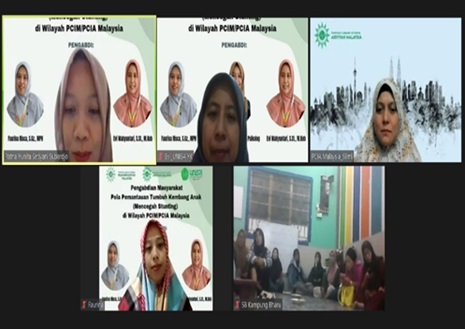Pola Pemantauan Tumbuh Kembang Anak di Wilayah Pimpinan Ranting Istimewa Aisyiyah, Kampung Bharu Malaysia Monitoring Patterns of Child Growth and Development in the Area of the Special Branch of Aisyiyah, Kampung Bharu Malaysia
Main Article Content
Abstract
Nutritional issues are still problematic for developing countries, especially in Southeast ASIA—activities as an effort to improve children's nutritional status. The method is carried out through 3 stages: preparation (coordination with partners, preparation of information media, namely exercise books and videos, TB and BB measuring equipment); Implementation (measurement of BB, TB, and BMI, analysis of nutritional status of children, counseling with experts); and monitoring and evaluation (evaluation of program sustainability). Based on the results of the service carried out, 11 (55%) children were well-nourished, 3 (27.2%) children were overweight, and 7 (35%) children were obese. Education and monitoring of nutritional status are needed for children in the PRIA Kampung Bharu Malaysia area who neglect physical activities and consume balanced nutritional food.
Downloads
Article Details

This work is licensed under a Creative Commons Attribution-ShareAlike 4.0 International License.
Authors who publish with this journal agree to the following terms:
- Any article on the copyright is retained by the author(s).
- Author grant the journal, right of first publication with the work simultaneously licensed under a Creative Commons Attribution License that allows others to share work with acknowledgment of the work authors and initial publications in this journal.
- Authors are able to enter into a separate, additional contractual arrangements for non-exclusive distribution of published articles of work (eg, post-institutional repository) or publish it in a book, with acknowledgment of its initial publication in this journal.
- Authors are permitted and encouraged to post their work online (e.g., in institutional repositories or on their websites) prior to and during the submission process, as can lead to productive exchanges, as well as earlier and greater citation of published work.
- The article and any associated published material is distributed under the Creative Commons Attribution-ShareAlike 4.0 International License
References
Ajayi, V. O. (2020). The UN Millennium Development Goals (MDGs) and Sustainable Development Goals (SDGs). Evaluating International Public Health 2 77–103. https://doi.org/10.1007/978-981-13-9787-5_4
Az Zam zami, A. H., & Rossa, E. M. (2021). Literature Review: Masalah Kesehatan Anak Jalanan. Jurnal Kesehatan, 12(3), 479–486. https://doi.org/10.26630/jk.v12i3.1993
Herfanda, E., & Wahyuntari, E. (2021). Optimalisasi Peran Dokter Cilik Di Sd Muhammadiyah Karangkajen Yogyakarta. Jurnal Pengabdian Masyarakat Sasambo, 2(2), 202. https://doi.org/10.32807/jpms.v2i2.772
Kemenkes RI. (2014). Peraturan Menteri Kesehatan RI No.25 Tahun 2014 Tentang Upaya Kesehatan Anak. Kementerian KesehatanRrepublik Indonesia.
Muhammad, H. F. L. (2019). Pemanfaatan sekolah sebagai sarana pencegahan obesitas sejak dini pada remaja. Journal of Community Empowerment for Health, 1(2), 107. https://doi.org/10.22146/jcoemph.39796
Rumana, N. A., Sitoayu, L., & Melani, V. (2019). Pengukuran Status Gizi Dan Edukasi Cuci Tangan Pada Anak Jalanan Rptra Gondangdia Jakarta. Jurnal Abdimas Kesehatan (JAK), 5(4), 267–271. https://doi.org/10.47007/abd.v5i4.2790
Saraswati, S. K., Rahmaningrum, F. D., Pahsya, M. N. Z., Paramitha, N., Wulansari, A., Ristantya, A. R., Sinabutar, B. M., Pakpahan, V. E., & Nandini, N. (2021). Literature Review : Faktor Risiko Penyebab Obesitas. Media Kesehatan Masyarakat Indonesia, 20(1), 70–74. https://doi.org/10.14710/mkmi.20.1.70-74
Sartika, R. A. D. (2011). Faktor Risiko Obesitas Pada Anak 5-15 Tahun. Makara Kesehatan, 1(1), 37–43. https://www.academia.edu/17631598/FAKTOR_RISIKO_OBESITAS_PADA_ANAK_5-15_TAHUN
Sidiq, R. (2018). Efektivitas penyuluhan kesehatan dalam meningkatkan pengetahuan kader posyandu tentang pencegahan pneumonia pada balita. AcTion: Aceh Nutrition Journal, 3(1), 22. https://doi.org/10.30867/action.v3i1.92
Susanty, A., Solichan, W. A., & Mukarromah, N. (2019). Hubungan Pola Makan dan Aktifitas Fisik dengan Status Gizi Anak Jalanan Kota Surabaya. Jurnal Keperawatan Muhammadiyah, 4(1), 156–161. https://doi.org/10.30651/jkm.v4i1.3447
UNICEF. (2020). Situasi Anak di Indonesia - Tren, Peluang, dan Tantangan dalam Memenuhi Hak-hak Anak. Unicef Indonesia, 8–38.
Wahyuntari, E., Fauzia, F., & Subarjo, R. (2022). Aksi Cegah Stunting Bersama IGABA Kapanewon Gamping. BAKTIMU : Jurnal Pengabdian Kepada Masyarakat STF Muhammadiyah Cirebon, 2(2), 215–224. https://doi.org/10.37874/bm.v2i2.462
